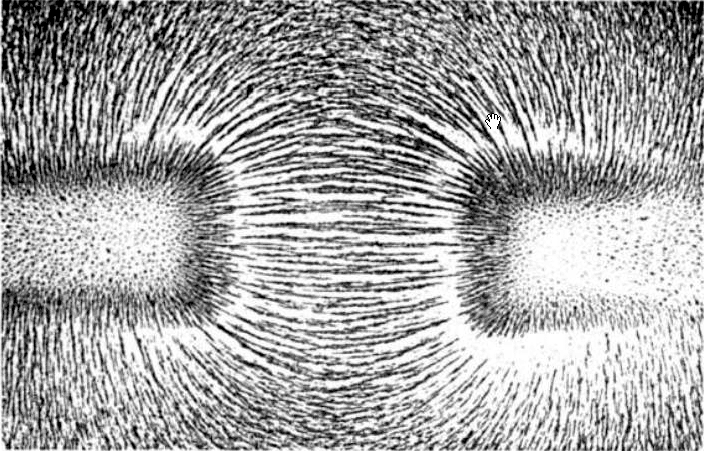Field Lines and Field Strength
Field lines serve as a visualization of the direction and relative strength of a vector field, which is a quantity that is defined in terms of a unique vector at each point in space. Field lines are not physically present, but instead serve to show the effect that a charged object has on the space around it. Along with field strength (the magnitude of the field) they can be used to solve problems about fields.
The electric field is a way of studying the effect that a charged object has on the space around it without placing test charges at a bunch of different locations as would be necessary with Coulomb's Law. The electric field also leads into discussions of electric potential, which provides a simpler scalar representation of the effect a charged object has on its surroundings.
 The magnetic fields of two north poles of different magnets interact to produce field lines in iron filings. Wikimedia
The magnetic fields of two north poles of different magnets interact to produce field lines in iron filings. Wikimedia
Contents
Field lines
Rules for field lines
The field points in the direction a positive charge would be pushed according to Coulomb's Law: away from positive charges and toward negative ones.
The density of the field lines at a point corresponds to the strength of the field at that point.
Field lines never cross.
What is the sign on the charged circular object with the electric field lines shown below?

At which point is the field depicted below stronger?

At which point would a positive charge experience a force in the downward direction?

Field strength
In physics, the field representation of any force is defined in terms of the quality that causes an object to experience said force. The field equation can be generated with
\[\text{Field}=\dfrac{\text{Force}}{\text{Quality}}. \]
| Force | Force Equation | Quality | Field Equation |
| Gravity | \(F_{g}=G\dfrac{Mm}{r^2}\) | \(m\) | \(g=G\dfrac{M}{r^2}\) |
| Electrostatic | \(F_{e}=k\dfrac{Qq}{r^2}\) | \(q\) | \(E=k\dfrac{Q}{r^2}\) |
| Magnetic force | \(F_{b}=q \vec{v} \times \vec{B}\) | \(q\vec{v}\) | \(\vec{B}=k\dfrac{I}{2\pi r}\) |
Thus, the strength of the electric field due to point charge Q can be found with the equation:
\[\begin{align} \vec{E}&= \dfrac{kQ}{r^2}\hat{r}\\ \text{where }k&= 8.99\times 10^9 \text{Nm}^2/\text C^2\\ Q &=\text{ Charge}\\ \text{and }r &= \text{Distance from the charge to the point of investigation} \end{align}\]
Since the electric field is a vector quantity, add multiple electric fields together according to the rules of superposition.
Two charges are on the x-axis. One of them is a \(4\ce C\) charge located at \(x = 0 \ce m\). The other is a \(1\ce C\) charge located at \(x = 1 \ce m\). Find the electric field at \(x = 0.5 \ce m\).
Solution: Each charge contributes a unique electric field vector, which are combined as a vector sum.
\[\begin{align} \vec{E_{net}}&=\vec{E_{4 C}}+\vec{E_{1 C}}\\ \vec{E_{net}}&=\dfrac{kQ_{4 C}}{r^2}\hat{r}_{4 C} + \dfrac{kQ_{1 C}}{r^2}\hat{r}_{1 C} \end{align}\]
Since the electric field points away from positive charges, the electric field from the 4 C charge points in the positive x direction, while the electric field due to the 1 C charge points in the negative x direction.
\[\begin{align} \vec{E_{net}}&=\dfrac{kQ_{4 C}}{r^2}\hat{x} + \dfrac{kQ_{1 C}}{r^2}(-\hat{x})\\ &=\dfrac{k(4)}{0.5^2}\hat{x} - \dfrac{k(1)}{(1-0.5)^2}(\hat{x})\\ &=\dfrac{k(3)}{0.5^2}\hat{x}\\ \vec{E_{net}}&=1.08\times10^{11}\dfrac{N}{C}\hat{x} \end{align}\]

Two charges are on the \(x\)-axis. One of them is a \(9\text{ C}\) charge located at \(x = 0\text{ m}\). The other is a \(1\text{ C}\) charge located at \(x = 1\text{ m}\). Find the location on the \(x\)-axis where the net electric field due to these charges is \(0 \text{ N/C}\).